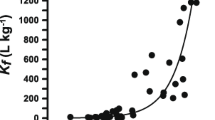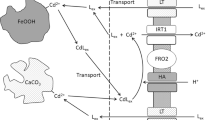Abstract
The Barber-Cushman model was evaluated for its ability to predict Cd uptake by maize (Zea mays L.) and by the Viviez ecotype of the Cd-Zn hyperaccumulator Thlaspi caerulescens (J & C Presl), both cultivated on a loamy soil enriched with cadmium sulphate (7 concentration levels). Shoots and roots were harvested after 12 and 24 days for maize and after three months for T. caerulescens. The quantity factor was estimated from different chemical extractions and from the isotopic labile pool E(t) measured using isotopic exchange kinetics (IEK). The capacity factor was calculated as the ratio of the quantity factor to the Cd concentration in the soil solution. It was also directly deduced from the IEK data. When using Cd extracted with a CaCl2 0.01 mol L−1 solution as the quantity factor, the model correctly predicted the Cd uptake by maize grown in non phytotoxic contamination levels (r2≈0.8–0.9). The ratio between E(t) and the Cd concentration in the liquid phase of the suspension used to determine E(t) also led to a correct prediction of the maize uptake. The latter was overestimated when using the amount of Cd extracted with a DTPA solution or the isotopic labile pool E(t) as the quantity factor. Where the soil Cd content exceeded 3 mg kg−1, phytotoxicity resulted in a 25% decrease in the biomass yield, and in a reduction of the Cd uptake which could not be predicted by the model. Phytotoxicity may have modified the absorption kinetic parameters of the maize roots. When using the capacity factors which the best simulated the uptake by maize, the model underestimated the Cd uptake by T. caerulescens. This was correctly simulated when using a higher capacity factor, calculated from the isotopic labile pool E(t) or from the DTPA extractable Cd. These results suggest that the soil capacity factor depends on the level of the soil's Cd depletion by the plant.
Similar content being viewed by others
References
Adams F 1974 Soil solution. InThe Plant Root and its Environment. Ed. E W Carson. pp. 441–482. University Press of Virginia, Charlottesville.
Adhikari T and Rattan R K 2000 Modelling zinc uptake by rice crop using a Barber-Cushman approach. Plant Soil 227, 235–242.
Arsenault J-L, Pouleur S, Messier R and Guay R 1995 Win-RHIZO, a root-measuring system with a unique overlap correction method. Hortscience 30, 906.
Barber S A 1995 Soil nutrient bioavailability. A mechanistic approach. John Wiley & Sons, New York. 414 pp.
Barber S A and Cushman J H 1981 Nitrogen uptake model for agronomic crops. InModeling Waste Water Renovation-land Treatment. Ed. J K Iskandar. pp. 382–409. J.Wiley Inter-Science, New York.
Boisset M 1996 Proposition de valeurs-limites pour le cadmium dans les aliments et les boissons. InPlomb, Cadmium et Mercure dans l'Alimentation: Evaluation et Gestion du Risque. Ed. CSHPF pp. 165. Lavoisier, Paris.
Byrne D 2001 Règlement (CE) N? 466/2001 de la Commission du 8 mars 2001 portant fixation de teneurs maximales pour certains contaminants dans les denrées alimentaires. InJournal Officiel des Communautés européennes. pp. L77/71–L77/12. Commission des Communautés européennes, Union Européenne.
Ciesielski H, Proix N and Sterckeman T 1997 Détermination des incertitudes liées à une méthode de mise en solution des sols et sédiments par étude interlaboratoire. Analusis 25, 188–192.
Claassen N, Syring K M and Jungk A 1986 Verification of a mathematical model by simulating potassium uptake from soil. Plant Soil 95, 209–220.
Echevarria G, Morel J-L, Fardeau J-C and Leclerc-Cessac E 1998 Assessment of phytoavailability of nickel in soils. J. Environ. Quality 27, 1064–1070.
Fardeau J-C 1993 Le phosphore assimilable des sols: Sa représentation par un modèle fonctionnel à plusieurs compartiments. Agronomie 13, 317–331.
Fardeau J-C, Morel C and Jappe J 1985 Cinétique d'échange des ions phosphate dans les systèmes sol-solution. Vérification expérimentale de l'équation théorique. C. R. Acad. Sci., t. 300, Série III, 371–376.
Gérard E, Echevarria G, Sterckeman T and Morel J-L 1999 Phytoavailability of cadmium in soils as assessed by isotopic methods. In5th International Conference on Biogeochemistry of Trace Elements, Vienna, 11-15 July 1999. Eds. W W Wenzel, D C Adriano, B J Alloway, H E Doner, C Keller, N W Lepp, M Mench, R Naidu and G M Pierzynski. pp. 134–135.
Gérard E, Echevarria G, Sterckeman T and Morel J-L 2000 Cadmium availability to three plant species varying in cadmium accumulation pattern. J. Environ. Quality 29, 1117–1123.
Houba V J G, Temminghoff E J M, Gaikhorst G A and van Vark W 2000 Soil analysis procedures using 0.01 M calcium chloride as extraction reagent. Comm. Soil Sci. Plant Anal. 31, 1299–1396.
Hutchinson J J, Young S D, McGrath S P, West H M, Black C R and Baker A J M 2000 Determining uptake of 'non-labile' soil cadmium by Thlaspi caerulescensusing isotopic dilution techniques. New Phytologist 146, 453–460.
ISO 2001 Soil quality-Dissolution for the determination of total element content-Part 1: Dissolution with hydrofluoric and perchloric acids (ISO 14869-1). International Organization for Standardization. 5 pp.
ISO 2002 Soil quality-Extraction of trace elements by buffered DTPA solution (ISO 14870). International Organization for Standardization. 4 pp.
Janot C 1990 Contribution à l'étude du transfert sol-plante du cadmium. Essai de validation du modèle 'Uptake' (Barber) pour Lactuca sativaL. & Lupinus albusL. DEA Thesis, Institut National Polytechnique de Lorraine, Vandoeuvre-les-Nancy. 50 p.
Kirk G J D 2002 Use of modelling to understand nutrient acquisition by plants. Plant Soil 247, 123–130.
Lasat M M, Baker A J M and Kochian L V 1996 Physiological characterisation of root Zn2+ absorption and translocation to shoots in Zn hyperaccumulator and nonaccumulator species of Thlaspi. Plant Physiol. 112, 1715–1722.
Lebourg A, Sterckeman T, Ciesielski H and Proix N 1996 Intérêt de différents réactifs d'extraction chimique pour l'évaluation de la biodisponibilité des métaux en traces des sols. Agronomie 16, 201–205.
Lebourg A, Sterckeman T, Ciesielski H and Proix N 1998 Trace metal speciation in three unbuffered salt solutions used to assess their bioavailability in soil. J. Environ. Quality 27, 584–590.
Lee D-Y 1993 Chelating resin membrane method for estimation of soil cadmium phytoavailability. Comm. Soil Sci. Plant Anal. 24, 685–700.
Lindsay W L and Norwell W A 1978 Development of DTPA soil test for zinc, iron, manganese and copper. Soil Sci. Soc. Am. J. 42, 421–423.
Lombi E, Zhao F J, McGrath S P, Young S D and Sacchi G E 2001 Physiological evidence for a high-affinity cadmium transporter highly expressed in a Thlaspi caerulescensecotype. New Phytologist 149, 53–60.
Mench M, Baize D, Denaix L, Sappin-Didier V and Sterckeman T 2001 Exposition de végétaux aux éléments traces via la solution du sol: Diagnostic de contamination des récoltes, diagnostic de danger, pratiques agricoles pour prévenir ou assainir. In5emes Rencontres de la Fertilisation Raisonnée et de l'Analyse de Terre. Les Nouveaux Défis de la Fertilisation Raisonnée, Blois, 27-29 novembre 2001. Eds. G Thévenet and A Joubert. pp. 317–331.
Mullins G L and Sommers L E 1986 Cadmium and zinc influx characteristics by intact corn (Zea maysL.) seedlings. Plant Soil 96, 153–164.
Mullins G L, Sommers L E and Barber S A 1986 Modelling the plant uptake of cadmium and zinc from soils treated with sewage sludge. Soil Sci. Soc. Am. J. 50, 1245–1250.
Nye P H 1992 Towards the quantitative control of crop production and quality. I. The role of computer models in soil and plant research. J. Plant Nutr. 15, 1121-1150. Nye P H and Marriott F H C 1969 A theoretical study of the distribution of substances around roots resulting from simultaneous diffusion and mass flow. Plant Soil 30, 459–473.
Page A L, Bingham F T and Chang A C 1981 Cadmium. InEffect of Heavy Metal Pollution on Plants. Ed. N W Lepp. pp. 77–109. Applied Science Publishers, London.
Peijnenburg W, Baerselman R, de Groot A, Jager T, Leenders D, Posthuma L and Van Veen R 2000 Quantification of metal bioavailability for lettuce (Lactuca sativaL.) in field soils. Arch. Environ. Contamination 39,420–430.
Reeves R D, Schwartz C, Morel J L and Edmondson J 2001 Distribution and metal-accumulating behavior of Thlaspi caerulescensand associated metallophytes in France. Int. J. Phytoremediation 3, 145–172.
Sadana U S and Claassen N 2000 Manganese dynamics in the rhizosphere and Mn uptake by different crops evaluated by a mechanistic model. Plant Soil 218, 233–238.
Schofield R K and Graham-Bryce I J 1960 Diffusion of ions in soils. Nature 188, 1048–1049.
Schwartz C 1997 Phytoextraction des métaux des sols pollués par la plante hyperaccumulatrice Thlaspi caerulescens. PhD Thesis, Institut National Polytechnique de Lorraine, Vandoeuvre les Nancy. 175 pp.
Silberbush M and Barber S A 1983a Prediction of phosphorus and potassium uptake by soybeans with a mechanistic mathematical model. Soil Sci. Soc. Am. J. 47, 262–265.
Silberbush M and Barber S A 1983b Sensitivity of simulated phosphorus uptake to parameters used by a mechanistic-mathematical model. Plant Soil 74, 93–100.
Steingrobe B, Claassen N and Syring K M 2000 The effect of the function type for describing the soil buffer power on calculated ion transport to roots and nutrient uptake from the soil. J. Plant Nutr. Soil Sci. 163, 459–465.
Wu Q T 1989 Biodisponibilité du cadmium dans les systèmes solplante. PhD Thesis, Institut National Polytechnique de Lorraine, Vandoeuvre-les-Nancy. 101 pp.
Author information
Authors and Affiliations
Rights and permissions
About this article
Cite this article
Sterckeman, T., Perriguey, J., Caël, M. et al. Applying a mechanistic model to cadmium uptake by Zea mays and Thlaspi caerulescens: Consequences for the assessment of the soil quantity and capacity factors. Plant and Soil 262, 289–302 (2004). https://doi.org/10.1023/B:PLSO.0000037049.07963.ab
Issue Date:
DOI: https://doi.org/10.1023/B:PLSO.0000037049.07963.ab




